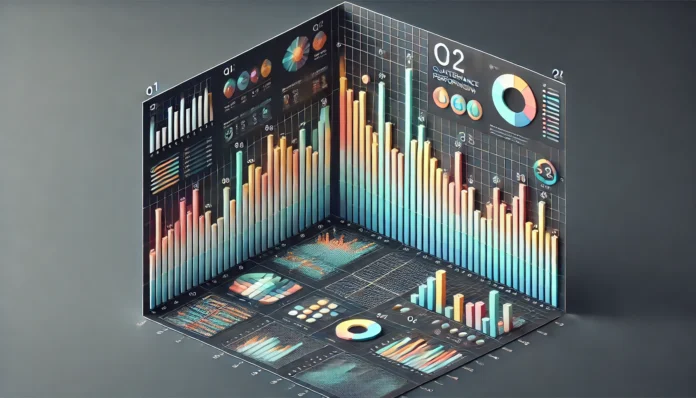Introduction
In today’s data-driven world, visualizing data effectively is essential to communicate insights. Whether you are building a website, dashboard, or personal project, Chart.js offers an easy and elegant way to create stunning data visualizations. This lightweight JavaScript library simplifies the process of adding responsive charts and graphs to your application.
This guide will walk you through how to integrate Chart.js into your project, step-by-step, along with customization tips and best practices for dynamic and interactive visualizations.
What is Chart.js?
Chart.js is an open-source JavaScript library that allows developers to create interactive and visually appealing charts with minimal effort. The library offers a range of chart types, such as bar charts, line charts, pie charts, and more, which are simple to implement and highly customizable.
With support for animation and responsive design, Chart.js is ideal for modern web projects, ensuring your charts look great on all devices and screen sizes.
Why Use Chart.js for Your Project?
There are several advantages to using Chart.js:
- Ease of Use: Its simplicity makes it beginner-friendly.
- Lightweight: Chart.js is compact, minimizing page load times.
- Responsive Design: Charts adjust smoothly to different screen sizes.
- Highly Customizable: Modify colors, labels, animations, and more.
- Supports Dynamic Data: Easily update charts with live data feeds.
Compared to other libraries like D3.js, which offer more advanced options, Chart.js stands out for its ease of integration without compromising essential features.
Step-by-Step Guide to Integrate Chart.js
1. Setting up Your Environment
Make sure you have:
- A code editor like VS Code.
- A basic HTML file for your web project.
2. Installing Chart.js
You can install Chart.js in two ways:
Option 1: Using CDN (Content Delivery Network) Add the following <script> tag to your HTML file:
<script src="https://cdn.jsdelivr.net/npm/chart.js"></script>
Option 2: Using npm (for Node.js Projects) Run this command in your project folder:
npm install chart.js
3. Creating Your First Chart
Let’s build a bar chart to get started.
<!DOCTYPE html>
<html lang="en">
<head>
<meta charset="UTF-8">
<meta name="viewport" content="width=device-width, initial-scale=1.0">
<title>Chart.js Bar Chart Example</title>
<script src="https://cdn.jsdelivr.net/npm/chart.js"></script>
</head>
<body>
<canvas id="myChart" width="400" height="200"></canvas>
<script>
const ctx = document.getElementById('myChart').getContext('2d');
const myChart = new Chart(ctx, {
type: 'bar',
data: {
labels: ['Red', 'Blue', 'Yellow', 'Green', 'Purple', 'Orange'],
datasets: [{
label: '# of Votes',
data: [12, 19, 3, 5, 2, 3],
backgroundColor: [
'rgba(255, 99, 132, 0.2)',
'rgba(54, 162, 235, 0.2)',
'rgba(255, 206, 86, 0.2)',
'rgba(75, 192, 192, 0.2)',
'rgba(153, 102, 255, 0.2)',
'rgba(255, 159, 64, 0.2)'
],
borderColor: [
'rgba(255, 99, 132, 1)',
'rgba(54, 162, 235, 1)',
'rgba(255, 206, 86, 1)',
'rgba(75, 192, 192, 1)',
'rgba(153, 102, 255, 1)',
'rgba(255, 159, 64, 1)'
],
borderWidth: 1
}]
},
options: {
scales: {
y: {
beginAtZero: true
}
}
}
});
</script>
</body>
</html>
Customizing Charts
One of the best features of Chart.js is its ability to customize charts. You can modify the following aspects:
- Colors and Fonts: Adjust colors, fonts, and labels to fit your theme.
- Animations: Enable or disable chart animations.
- Responsive Settings: Ensure your charts adjust automatically to different screen sizes.
- Tooltips and Legends: Customize how tooltips and legends appear.
For example, in the above bar chart, you can change the backgroundColor or update the labels to match your data.
Chart Types Available in Chart.js
Chart.js offers a variety of chart types, including:
- Line Charts
- Bar Charts
- Radar Charts
- Pie and Doughnut Charts
- Bubble Charts
- Polar Area Charts
Each chart type serves a specific purpose. For instance, line charts are great for trends, while pie charts work well for showing proportions.
Handling Dynamic Data in Chart.js
Chart.js allows you to update charts in real-time by manipulating the dataset and calling the update() method. Here’s a quick example:
myChart.data.datasets[0].data = [10, 15, 8, 6, 5, 4];
myChart.update();
This makes Chart.js ideal for dashboards that need to reflect live data, such as stock prices or user activity.
Best Practices for Stunning Visualizations
- Keep it Simple: Avoid clutter and focus on key data points.
- Use Appropriate Charts: Choose the chart type that best conveys your data.
- Optimize for Mobile: Ensure your charts are responsive.
- Leverage Colors Wisely: Use contrasting colors to make data points stand out.
- Label Everything Clearly: Include meaningful labels, legends, and tooltips.
Conclusion
Integrating Chart.js into your project is a simple and effective way to create interactive, responsive, and visually stunning data visualizations. With its variety of chart types and customization options, Chart.js empowers developers to present data beautifully, whether on a dashboard or a website.
So dive in, experiment with different chart types, and transform your data into powerful visual stories!



